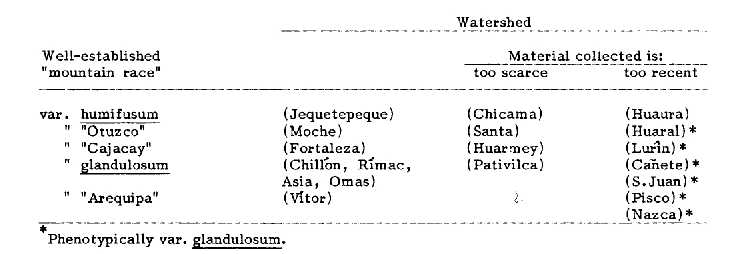At the northern end of the range, it is highly doubtful whether the peruvianum range extends into
Ecuador. Presumed collections of this species, including Blood and Tremelling's PI 129150 & 129151
(west of Guayaquil) and Winters and Clark's PI 390516-390518 (vicinity of Jipijapa) have been
positively identified as L. hirsutum f. glabratum.
The coastal type of group 3 is fairly uniform with the exception of collections from the Chilca-
Topará district, which differ from others in highly compound and more canescent leaves and
condensed inflorescences. This exceptional race shows peculiar crossing affinities with northern
mountain races like Otuzco and var. humifusum and L. chilense (Rick 1963). The coastal type is well
exemplified by the Culebras accessions (PI 126944126946, LA372, 374). Except for the
aforementioned Chilca-Topará race, no striking genetic or morphological differences have been
detected to date between Culebras and Nazca (fig. 1). The plants are generally found as weeds in
populations of one to hundreds in fields of sandy or sandy loam soil. A few specimens have been
collected in dry washes after huaycos (avalanches of stones and mud) or after a normal rainy season.
In the latter sites they are commonly sympatric, but usually in lower, slightly moister positions,
indicating a certain similarity in moisture and drainage requirements. As weeds, the plants can be
found at any time of the year depending on the irrigation regime.
The mountain races of L. peruvianum, found 1200 m and higher, are based on genetic relations
and phenotypic observations (Rick 1963), which always have to be taken with much care in working
with this species. The watersheds are divided into three groups as follows:
Except for var. humifusum, which is usually found in populations of a few individuals, the other
"good" races usually consist of many plants at different sites over an altitude range of 750-1200 m at
the lower limit and 2000-3000 m at the upper limit. Sympatry with L. hirsutum is common between
1200 and 2500 m; with S. pennellii, at around 1200 m from the Casma to the Pisco. Cohabitation
with L. pimpinellifolium is often observed at the lower elevations. Specific plant associations are
mentioned by collectors for only 30 sites. The associations stated more than once are: Loaza spp.
(13% of the cases); Jatropha and Heliotropium (10%); and Zinnia and Onoseris albicans (7%).
General vegetational data are presented for 50 sites. The situations vary from no vegetation or
dormant vegetation (two cases), association with grasses, Compositae, or a yellow-flowered legume
(three cases each), with cacti (six cases), and as a weed (six cases). It is safe to generalize that the
main characteristic of peruvianum habitats is dry to medium dry conditions, which are specifically
mentioned in 50% of the sites.
d. Solanum pennellii (Table 4). Seed collections have been mainly successful from October to December
and only two sites above 1600 m have been recorded: Tingo-Pacaraos (Huaral) at 2300 m and km
70 road to Canta (Chillón) at 1800 m.
No navigation control above? Click here!

